Hastings Jetty and its fishing shed date from about 1866 when a mix of British and Sicilian guys began to supply the growing Melbourne market. A pretty tranquil spot today.
My experience on the pier
I probably ought to call this place Hastings Jetty rather than Hastings Pier. That’s the name on the official signage at the shore end of the pier, and it’s a very different place from the Hastings Pier I knew back in Sussex, which was very much one of those 19th century ‘pleasure piers’ popular in the UK at the time.
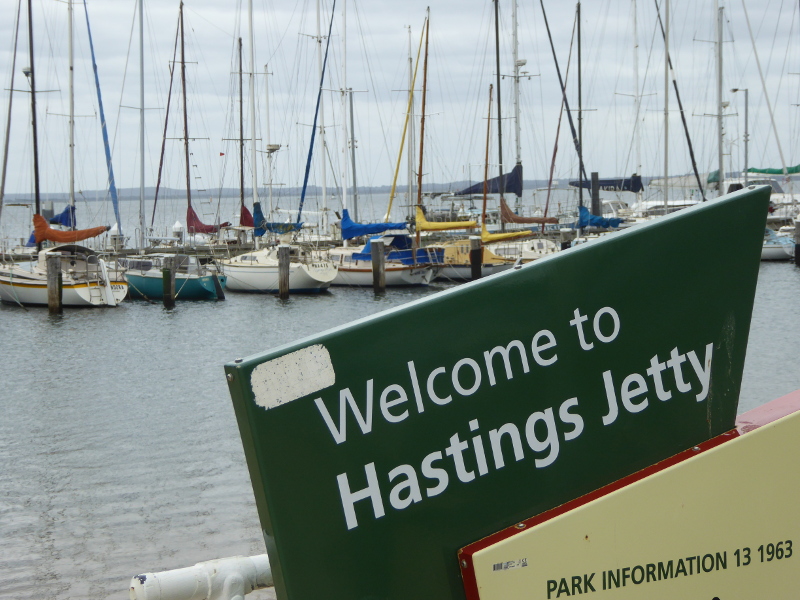
Hastings Jetty was built for fishing, and its iconic 1866 fishing shed still stands proudly on the sand at the start of the pier. It’s a visitor information centre now, and it was closed on this January Friday I dropped by for a look, but there’s enough information on and around the shed to keep most people interested, even when the shed is locked up.
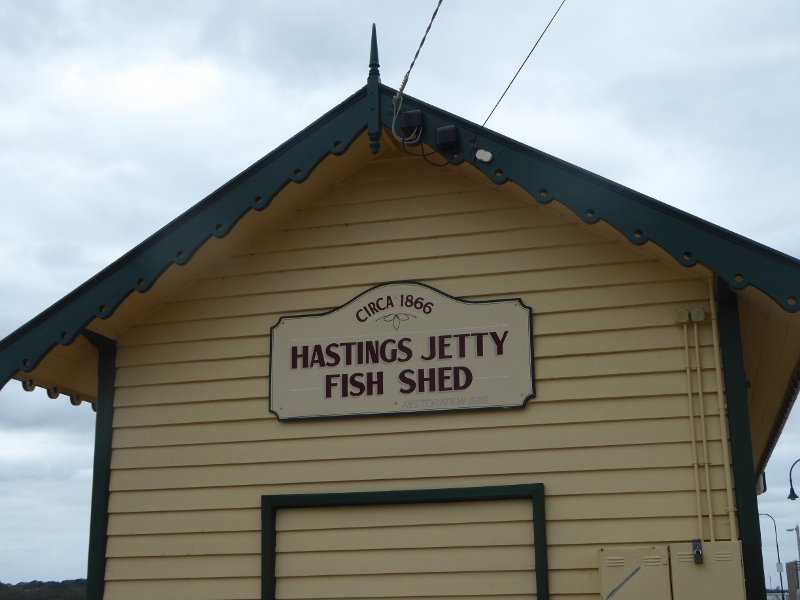
It must have been low tide when I got to Hastings, as the shed was perched up on its short stilts above wet but firm sand, suggesting that at high tide those stilts get their feet wet.
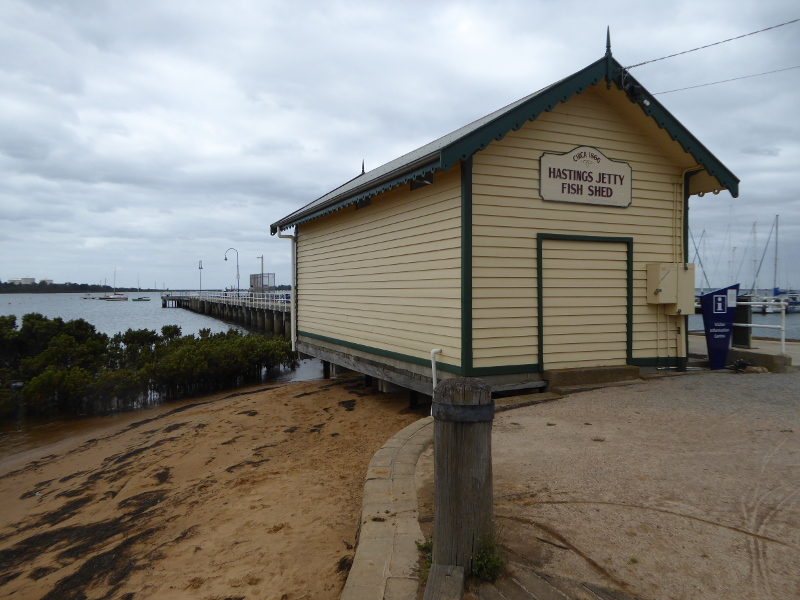
All around on the sand flats here are mangrove trees. Apparently the most southerly mangrove species in the world (I learnt from the boards on the shed…). Last time I was anywhere near mangroves, I was on the look-out for crocs, but there’s nothing like that this far south.
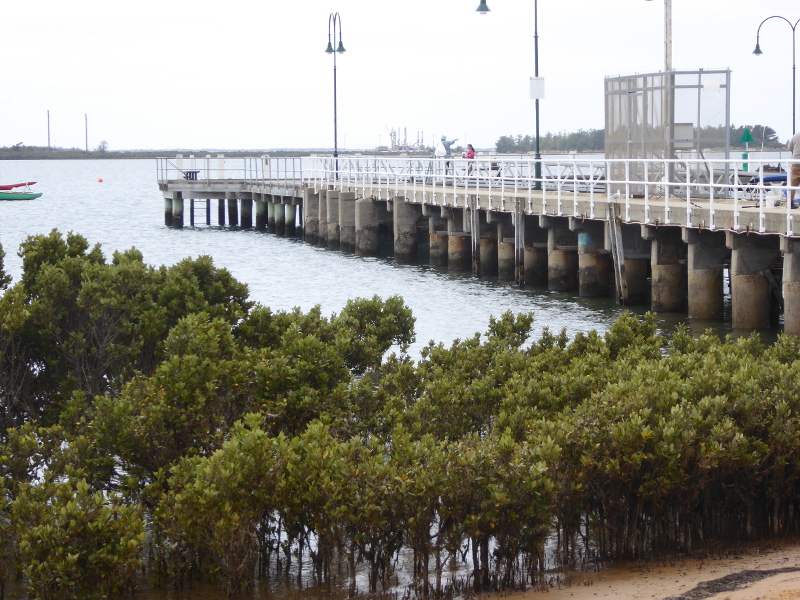
You’re more likely to see pelicans than crocodiles at Hastings, though there were none in view for my trip, apart from these guys lining up near the aquatic centre by the shore.
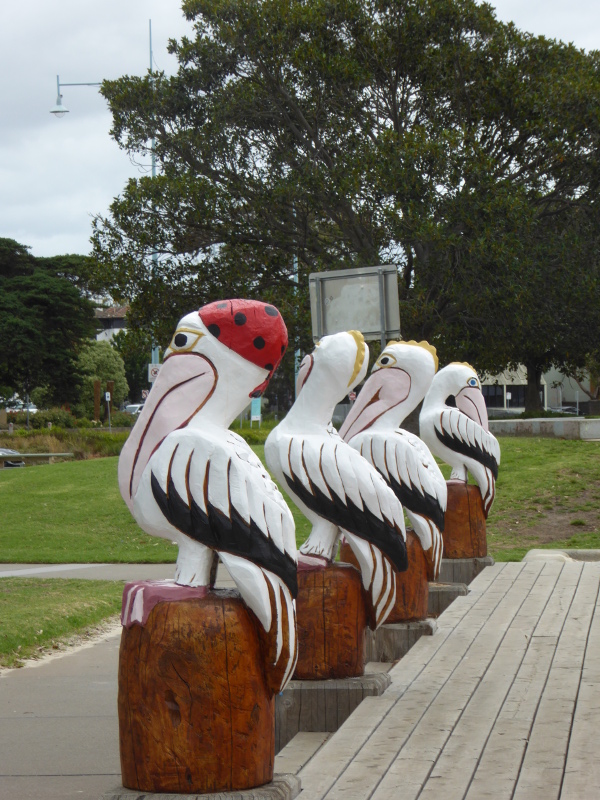
I rather liked the pelican theme to the Hastings swimming pool (more wooden carvings out the back of the aquatic centre, and a hint of pelican sculptures inside the pool building, too). Even the pool café, looking out over the pier, is called Pelikan Societe (though I’m not sure of the reason for that bizarre spelling of either word…).
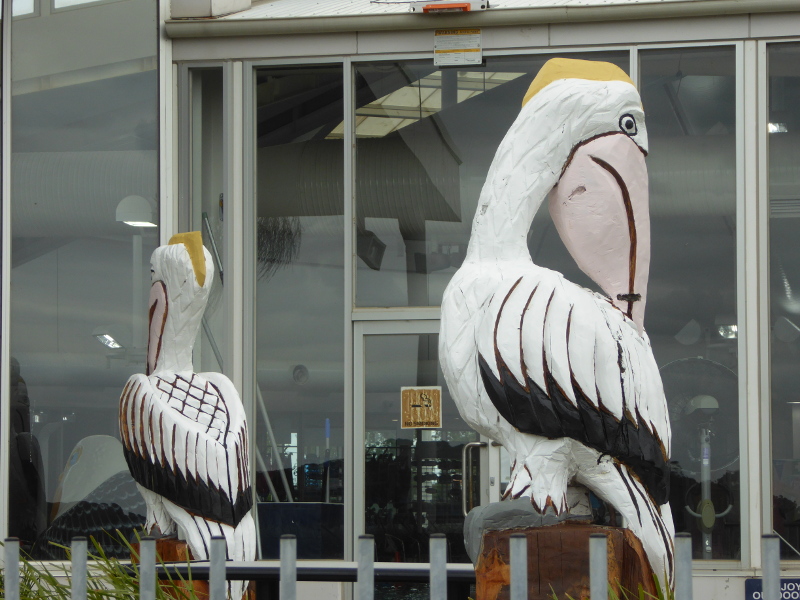
I always think it’s a bit of a shame they did away with the lovely old vintage outdoor pool, which is what happened in Hastings as in so many places round Victoria, but the pelicans go some way to making up for that. And they named the parkland reserve near the pool after the gent who looked after that original outdoor pool, so that’s a nice touch.

The first 100m or so of the Hastings Jetty is concrete, and that’s the feel underfoot as you start off from the fishing shed.
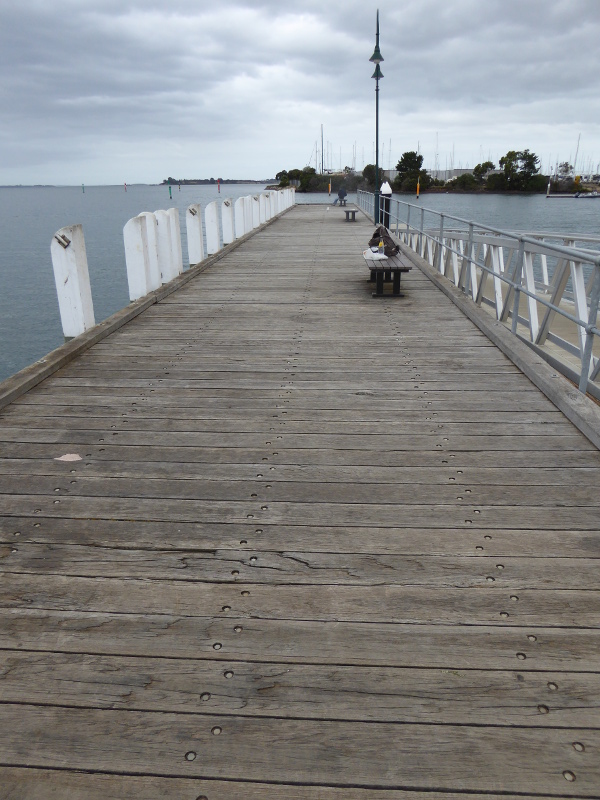
Then it switches to boardwalk, which is what makes a pier a pier in my book. Hastings Pier has an L shape, with a cross-section – all boardwalk – which is probably as long again as the concrete section.
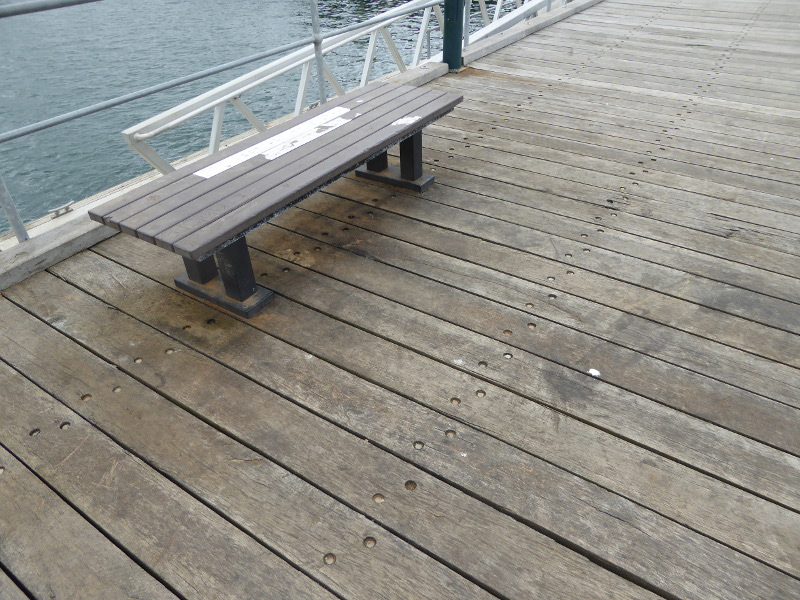
There are three benches out along the right-hand leg of the pier, one of which was free for me to sit awhile. The other two were being used by guys fishing.
So fishing is important to Hastings Jetty in 2020, as much as it was in the 1860s. Apparently the 40 fishermen who worked to have the first pier built all came from the UK or Sicily. From the look of the old gents fishing in 2020, they may even have been offspring of those original folk, though more likely the Scottish than the Sicilian line.
There was also a couple of Chinese groups out there with a rod and line, one a patient father taking his two kids out for a summer holiday outing, with the young son looking slightly more enthusiastic than the daughter…
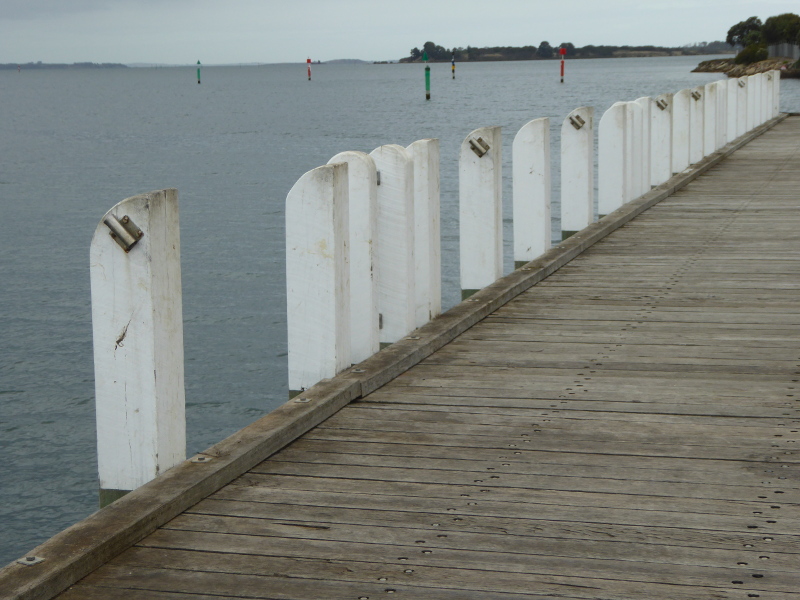
Along the seaward side of the jetty were 30 white posts, some of which had a useful little metal tube, into which fishing folk could drop their rod and leave it while tending to something else. I’m not sure what other purpose these white posts have, though?
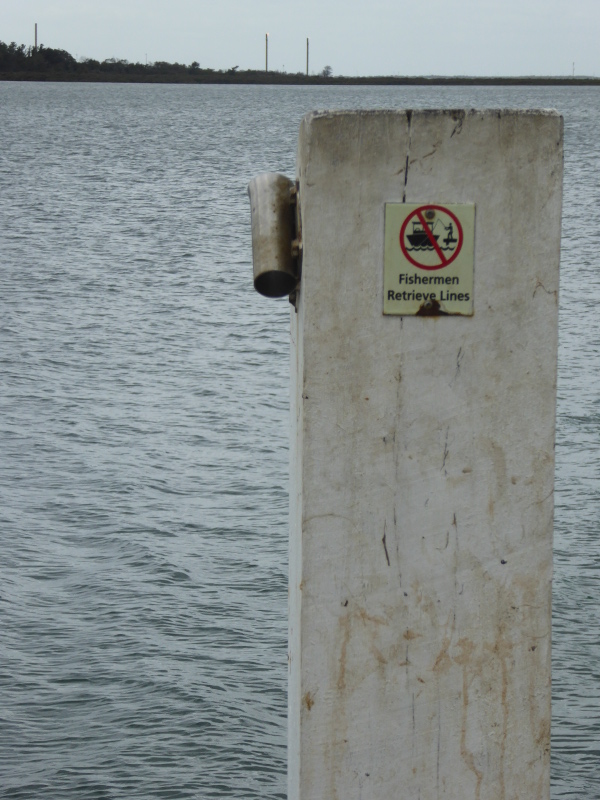
On the harbour side, there were two proper mooring piles, and a lower level of the ‘pier’ for people to embark or get back on land.
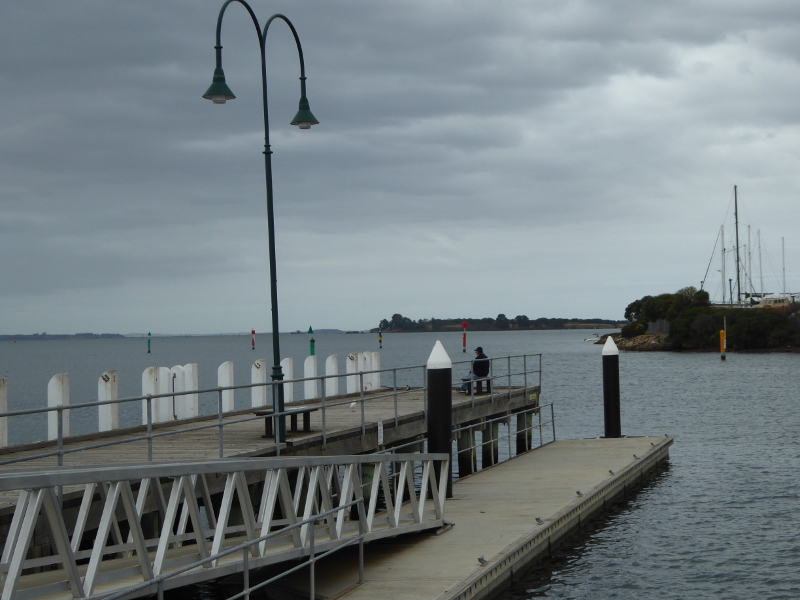
And half way along the concrete section of the pier was a little marina, with enough berths for 20 or so small vessels.
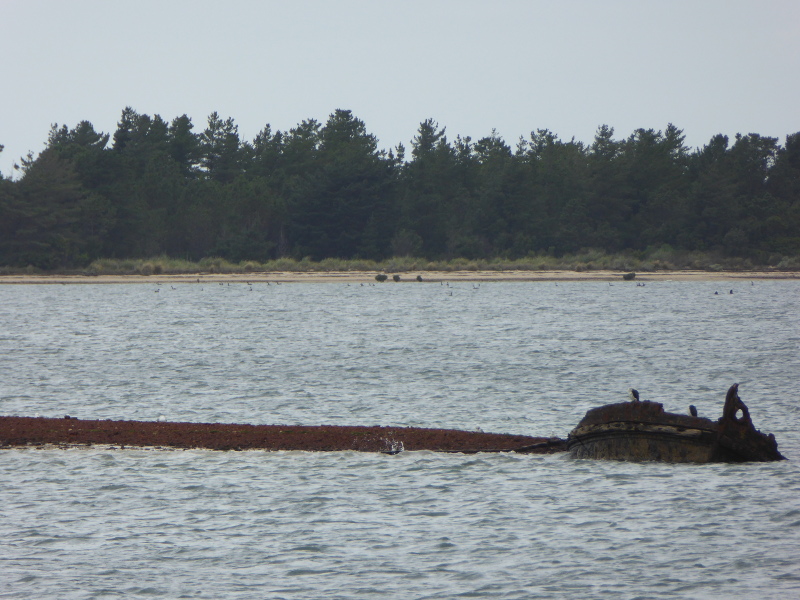
I checked with one of the fishing gents if this area 200m out in the bay was a mudbank or part of the hull of a shipwreck, but he confirmed it was the slightly less exciting mudbank (see one of the links I found, below, though…)
It was nice to see people out for a walk along the pier. One family was out for a summer stroll; another gent pushing his wife in a wheelchair for a breath of fresh air.
And sure enough, it was breezy out there on the cross-section of the pier, so I had to hang onto my hat the whole time.
The pier has a series of lamps, which must mean it’s lit up at night (again, check out the links below…)
And there are no city views out on the horizon here. We are facing the wrong way in Hastings. But the 1970s saw developments of first Esso and then Bluescope Steel, so those are the companies involved with the industrial-looking sheds over the water from the pier.
Back on land, I learnt that Hastings sits right on the Western port bay trail, which is great for walking and cycling.
Over the road from the pier is a flimsy-looking building housing the museum of the local historical society. Sadly no access for me on a Friday, as this is only open on Wednesday mornings, and Sunday afternoons, so not for my trip this time.
Practicalities
No shelter on Hastings Jetty, unless the Information Centre in the old fish shed is open. But there are benches to rest up on the pier.
There are public toilets on the reserve to the town side of the aquatic centre.
History and stories about Hastings Pier
According to the noticeboards near the pier, there were just 40 fishermen who got together in 1864 to build what they then called the Star Point Jetty. These were guys mostly from England, Scotland, Wales and Sicily, making me wonder if Sicily had the same connotations for the Brits then as it would do now?
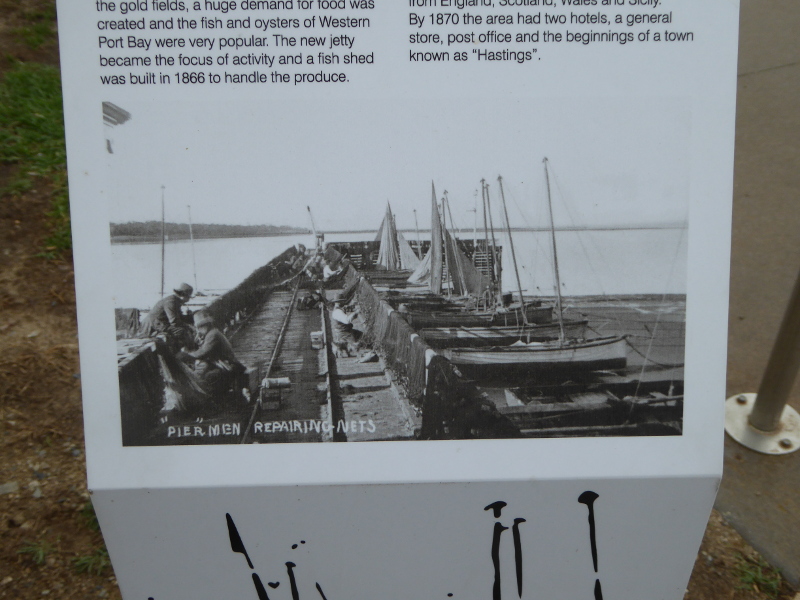
The demand for fish and oysters came from wealthy and successful gold diggers now based in Melbourne, and by 1866, they had built the fish shed which basically stands there today to help sort and store the fish.
The first mention on Trove dates from 1868, by which time the pier was known as Hastings Jetty, and there were announcements of a new light to help fishing boats find their mooring from sunset to sunrise.
There were no major incidents that made the newspapers in those early years, though I did notice that a Thomas Box won a certificate of merit from the Royal Humane Society for jumping into the water off the jetty and saving two young boys (aged 5 and 7) who had fallen in, so I wonder how many other incidents there were like that which didn’t make the news?
In the 1880s, the L section of the jetty was added.
One report, from October 1889, spoke of a picnic party which set off from Hastings Jetty, but ran into a gale half way home on the bay. The boat went ashore some five miles from Hastings, and although a new boat was found to take the party (mostly ladies) home, the majority elected to walk from Stony Point, and arrived well after dark.
Another boating incident in a storm had a less happy ending just a few months later. Four men were dumped into the water about two miles from Hastings Pier when their boat capsized; two brothers on board couldn’t swim; one of them was saved by another crew member, a Sebastiano Orsino, who had hero status in the village as a result; sadly, the other brother drowned.
A quick genealogy search suggested that Orsino lived on to the ripe old age of 95, and he’s buried in the cemetery just across the bay near the Esso buildings. What an amazing character he must have been, but how did locals treat him once war broke out in 1939? I’m not sure all Germans and Italians got on too well in the war years, but surely a 90 year old with that local hero story behind him meant his Italian background didn’t count against him…
Hastings Pier became the gathering point for a range of people from Melbourne in 1892, as they caught boats towards Phillip Island, where they were to collect eggs from the nests of mutton-birds (a local name for the common shearwater bird). This was clearly a middle-class activity back then, as The Argus reported that one party included a lawyer, a doctor, ‘racing men’, and ‘several ladies’. They loaded hampers of poultry, preserved meats and ale onto the boats, so this was clearly regarded as a fine picnic-style outing.
There was further tragedy off Hastings Jetty in 1903 when a young woman was found drowned near the pier. She had been suffering bouts of insomnia, apparently, and had gone to Hastings for a change of air. Only 32 years of age, she was reportedly in ‘good spirits’, except when she had a new episode of insomnia. She left a note in her boarding house, asking forgiveness for what she was about to do…Very sad for her photographer husband back in Kerang.
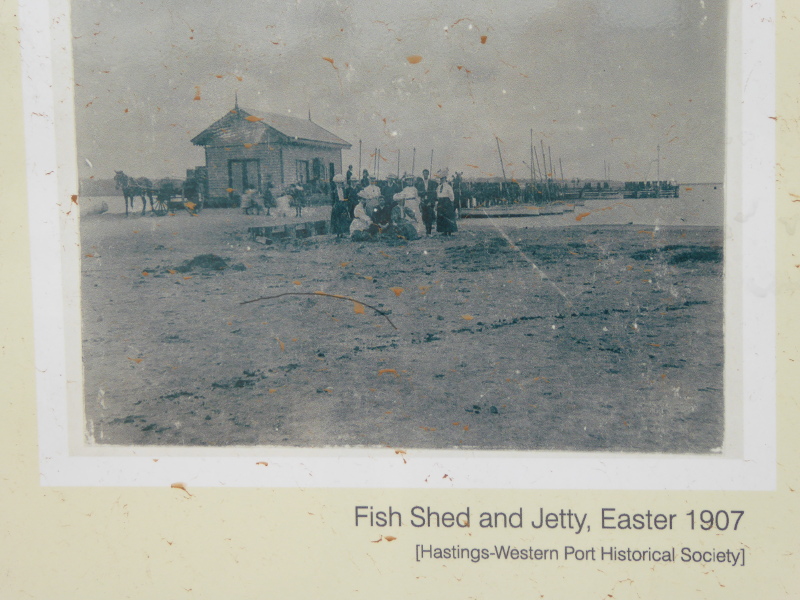
Since fishing has always been the main reason Hastings Jetty exists, we can’t finish the ‘history’ section without a fishing ‘story’…In 1909 three men went out from Hastings Pier in a small boat. Almost as soon as they put out bait, an enormous shark took hold and set its teeth into the stern of the boat until the men speared it off. This shark was almost 5 metres long, and when finally it was got to shore, inside its gullet was apparently a whole porpoise. Enough to put me off ever thinking about swimming off Hastings Pier, that’s for sure.
There was a proposal in 1913 to move the jetty and create a railway pier in Hastings to make the town the main port for bigger ships and connections into the mainland by rail. This clearly never came into being…Not only that, various council discussions through World War One covered the problem for pedestrians reaching the Hastings Jetty at high tide, but with financial priorities elsewhere at the time, the road to the jetty couldn’t be raised at that time. So it must have been well and truly submerged at high tide in those days.
Stories on or around Hastings Pier or Jetty were few and far between after World War 1. Maybe life just got into a peaceful routine, with little changing for a while down here. A newspaper piece from 1923 suggests so: “The fishing fleet moored at the Hastings Pier has a prosperous look. The boats have motor power. The fleet puts to sea for days together and brings its haul in for rail regularly by the Stony Point fish trains to the Melbourne market.”
It was not all peace and tranquillity, though. Later that same year, two fishermen lost their lives when their boat capsized in a storm not far from Hastings. The fact that they were wearing full oilskins and leggings meant that they couldn’t swim to safety in the rough seas.
Other than that, it was all quiet on Hastings Pier, at least for the years covered by the Trove database. Some excitement was caused by installation of the first electric lights on the pier in 1930, with more agreed in 1937. In 1939, Sebastiano Mirabella, one of the original fishermen from Sicily, landed a 3m shark on the pier at the grand old age of 80.
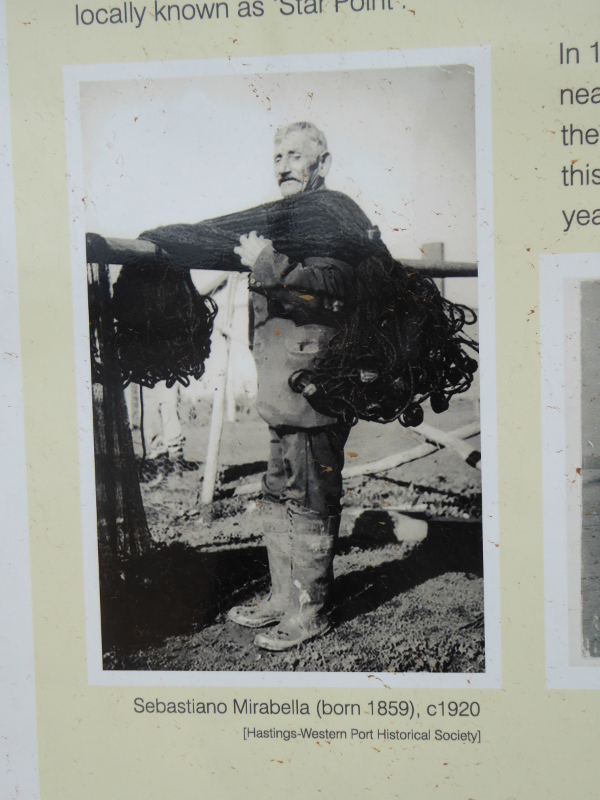
If anyone can fill in the missing years, basically from the end of World War 2 to the present day, with any tales of the Hastings Jetty or Pier, I’d love to hear them.
All I know is that in 1988 the fishing shed was restored, thanks to which we have the splendid building that still stands today at the shore end of the pier.
Other links and writings on Hastings Pier
The Mornington Peninsula tourism site has a page on Hastings Pier.
Some rather good pre-dawn photos of the Hastings Jetty here.
A short Youtube video from Hastings Pier.
Thanks to this photo it looks as if what I saw was both a sandbank and a shipwreck of sorts.
This blog post dates from 2012, when the fish shed had only just relocated elsewhere in town…
This piece is on one of the original Sicilians, Sebastiano Mirabella.
What are your stories and memories of Hastings Pier?
Are you a regular down at Hastings Jetty? Do you go for the fish or the fresh air?
Does anybody know what happened to those Sicilians during the Second World War? I so hope they weren’t interned like many Germans and Italians during the war years?
Comment below if you have anything to add, especially with stories of your own favourite times on Hastings Pier, especially if you have any good stories to fill in my gaps after the War…
Coffee or tea near the pier?
The coffee I had in town was fairly ordinary so I think next time I’ll be going to the Pelikan Societe (though I’ll be annoyed if nobody knows why it’s written that way…). Still it has great views over the pier and fish shed.


I was was the instigator of the Fish shed restoration. Undertaken by myself, Bill Patience the 3rd ,and Doug Norton. Sigh on shed says local volunteers, which gives wrong impression. Our only chance to go down in History. blown by bureaucrats. There is a great story attached to the operation .The wreck off the jetty is the Red Bird . Came there during second WW.. Engine trouble on way to Northern waters. another good story. My grandfather arrived in Hastings in 1860 age 18 another great story, ranging from wealthy Industrial cotton industry England to Hastings.. I can tell you history, from then until now, although, probably not sure about yesterday .
Regards
John Woolley
Very interested in speaking to you, John. I’ll send you an SMS, and will try to come down to see you once we are able to travel freely again
Hi Simon, I have a great story about Port Welshpool Long Jetty , Approx,900 metres.. Typed all the basis of the history, then moved the cursor and it wiped it ,that is an example why I hate computers . Look forward to chatting. i have been in involved with various elements of the maritime industries . I have written my working history which I can forward you, if I have an email address .When giving talks, I say, I am not a historian , but a story teller. That means the real interested people can do their own detailed research..
Hi John, I have an old photo that looks like the shed. and pier. circa 1898 .. not sure.. if it is not, then it is its twin sibling .. are there any.. do you have any old pics of the original shed… cheers Mil
Hi Milton, I am the President of the Hastings-Western Port Historical Society and would be please to see your copy of the shed to see if we actually have a copy. I can me contacted at info@hastingsmuseum.org.au if you wish to make contact. Cheers, Di Maloney 0490 132 011
Great read. Sebastian Orsino is my great grandfather, on my maternal line. He, along with his brother arrived in Hastings from Sicily by their own means in 1860.
It took them the best part of 9 months to sail from Sicily to Port Philip Bay. He was 16 years old when he arrived safely and well. He is amongst the first Italians to migrate to Australia.
He along with his mates in Hastings, established the fishing co-op which was the forerunner of the Flinders Street fishmarket.
Regards John Guest
Thanks for getting in touch, John. I’d love to hear more on the Orsinos if you have more to tell. I’m preparing a podcast episode on Hastings, in case you might be interested in adding your stories?
Hello John and simon. I am also related to Sebastiano as my grandmother Rita was an ORSINO. She married Ernest COVEY. Be great to speak in person. I have his royal humane society medal for saving the people from the boat that capsized off Hastings pier.
Great to hear from you Paul. Did your grandmother talk much about her childhood and the Orsinos of Hastings?
I dont recall ,sadly she passed away in 1984 when I was 12 years old. She was living in Rosebud at the time.
Hi Paul et al, I just got this chain of emails. It would be great to talk. Not sure the best way to do this. I also a 2nd great grandson of Sebastiano and fell into the role of keeper of records for our line. Let me know the best way to connect. Cheers John Guest
PS: I am a 2nd great grandson of Emily McArcardle, nee Orsino
Hi John, here is my email address
covey1972.pc@gmail.com